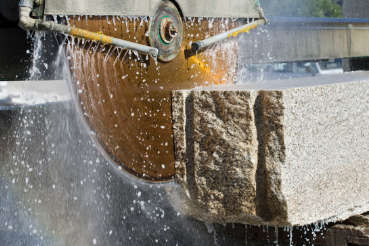The treatment of natural stone water has been an important part of our activity for several years. Our plants offer a variety of ways to purify wastewater from stone processing plants.
Ideally, the production effluents are collected in a central storage tank and led from here to the subsequent stage (sedimentation or filtration). But it is also possible to use the treatment level from different storage tanks. When designing the storage tank, it must be ensured that fluctuations in the inlet flow can be reliably compensated. However, it should not be too large so that deposits do not arise here. For reducing deposits agitators or pneumatic lifting devices are used.
Normally, sedimentation is the first treatment stage of wastewater. In the past, simple settling tanks or clarification pons were often used. The use of lamella clarifiers (lamella separators) has proven particularly useful. These devices are very compact and can be designed for operation with and without flocculants. The resulting sludge can then be removed e.g. drained via big bags, drainage containers or vacuum belt filters. The purified water from the lamella separator is usually passed over a slope in a storage tank. From here it is pumped back to the individual processing machines with a pressure booster system.
For smaller wastewater volumes of up to approx. 10 m³ / h, sedimentation can be dispensed with, depending on the solids content, and the wastewater can be fed directly to a vacuum belt filter (VBF). In this case, the treatment steps "sedimentation" and "sludge dewatering" are combined, whereby the wastewater is purified in one step and the solid is transferred to a set state.

Our products are available to rent for pilot tests. Due to our extensive rental park, we can put together complete test systems individually for your task.
In a factory where fireproof ceramic is produced, the products are processed mechanically (cut and grinded) after firing. Water is used to cool down the processing tools. After the processing the water is polluted with fine ceramic particles.
To be able to reuse the water or discharge it into the canalization the dirt particles have to be removed. For this purpose Leiblein GmbH developed an innovative treatment system.
Functional descriptionThe polluted grinding water is collected in a pit and with a centrifugal pump led to a flocculant plant and finally to the lamella separator. By addition of flocculant, even the finest particles can be separated. Sedimentable particles are separated in the lamella separator. The purified water flows into the clean water tank and is pumped back to the grinding machines with a centrifugal pump.
The sediment accumulates in the sludge funnel and is kept in a liquid state by a rabble rake. An eccentric screw pump pumps the sludge at regular intervals into a dewatering container for further drainage.
The plant constantly runs during the production processes, after the processes are stopped, the rabble rake still runs for a certain time while the clean water pump is turned off. Waterlosses are automatically compensated by the system.
Salt extraction from brine offers significant advantages, compared with conventional mining. No costly shafts and tunnels are required and fewer personnel are needed.
The brine is soiled with chalk, plaster, clay and so on. The brine is led into a Leiblein lamella separator. Sedimentable particles separate and accumulate in the sludge funnel. The sludge is pumped into a filter press for further thickening or dewatering.
In a factory where newly produced concrete slabs are cut, cooling water is needed for the cutting machines. The concrete is not fully hardened yet. In order to reuse the water, solids and other particles which can deposit in the pipes and nozzles have to be removed.
The polluted cutting water is pumped into the Leiblein lamella separator. The solids settle onto the lamellas and slide into the sludge funnel at the bottom. The clarified water flows to the top and into the clean water tank.
The sludge and coarse solids are exported by a conveyor screw. In comparison to eccentric screw pumps the conveyor screw has the advantage that also larger particles can be exported and that the solids are much dryer.
Technical details
| Water inlet lamella separator | 0,5-1,5 m3/h |
|---|---|
| Clarifying area: | 6 m² |
| Clarifying area load | 0,08-0,25 m³/m²*h |
| Material lamella separator | steel coated |
| Material lamellae | PP |
| Lamella distance | 40 mm |
| Inclination | 60° |
| Discharge screw | Ø 250 mm / Hardox |
The moulds used for brick production are made of plaster which pollutes the water used for the processing. The effluent, containing plaster particles of all sizes, is treated by a two-stage process planned by Leiblein GmbH.
At first the larger plaster particles are removed from the effluent with a conveyor screw. Then the plaster water is purified of the fine particles by a Leiblein lamella separator.
Through this process it was possible to convincingly meet the high demands on the purity of the effluent.
The wastewater of a porcelain factory is collected in a pit, which acts like a buffer and equalises the amount of water. The water is led to a flocculation stage, where flocculant (for example: Sachtofloc 46.12 ) is added to gain easily sedimentable flocks.
The water flows gently into the lamella separator, where the flocks are separated. The clarified water flows into another pit and is either led into the canalisation or reused.
The sludge, which is collected in a funnel at the bottom of the lamella separator, is led into a container and gets pumped into a filter press for further thickening.